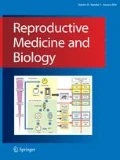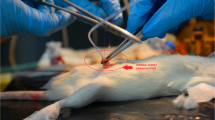Abstract
Aims
The aim of the present study was to determine the effect of orchid bulbs on the reproductive system of male albino mice.
Methods
Orchid bulb extract was fed to 20 male albino mice (5 g/mouse/day) for 35 days and compared with a similar number of mice as controls. Total testicular germ cell population, histometrical parameters, serum blood biochemistry and hormonal assay were determined.
Results
The ingestion of orchid bulb by mice induced a significant increase in the following parameters: (i) testes and seminal vesicle weights; (ii) number of different testicular germ cell population including interstitial Leydig cells and fibroblasts; and (iii) testicular cell linage dynamics obtained from testes and cauda epidydimides. An important finding was that the ingestion of the orchid diet by male mice increased their fertility. This was indicated by an elevation in the number of impregnated females when allowed to mate with treated mice, an increase in the impregnation sites, and an increase in the number of viable fetuses and the offspring’s male/female ratio. A slight significant increase in the testosterone and follicular stimulating hormone titers in the treated mice were found in their blood serum. In contrast, a decrease in the number of degenerating cells was observed.
Conclusions
Orchid bulb treatment might play an important role in improving male reproductive potential and fertility.
Similar content being viewed by others
References
Lim KG, Dunn WF, Klarich KW, Afessa B. Internal medicine resident education in the medical intensive care unit: The impact on education and patient care of a scheduling change for didactic sessions. Crit Care Med 2005; 33(7): 1534–1537.
Van der Pijl L, Dodson CH. Orchid Flowers. Their Pollination and Evolution. Coral Gables. University of Miami Press, Florida, 1966.
Dafni A, Bernhardt P. Pollination of terrestrial orchids of Southern Australia and the Mediterranean region. Systematics, ecological and evolutionary implications. Evol Biol 1990; 24: 193–253.
Gravendeel B, Smithson A, Slik FJ, Schuiteman A. Epiphytism and pollinator specialization: drivers for orchid diversity? Philos Trans R Soc Land B Biol Sci 2004; 359: 1523–1535.
Kong LM, Goh NK, Chia LS, Chia TF. Recent advances in traditional plant drugs and orchids. Acta Pharmacol Sin 2003; 24: 7–21.
Lin WS, Chan WCL, Hew CS. Superoxide and traditional Chinese medicines. J Ethnopharmacol 1995; 48: 165–171.
Hew CS, Arditti J, Lin WS. Three orchids used as herbal medicines in China. An attempt to reconcile Chinese and Western pharmacology. In: Arditt J, Pridgeon AM, eds. Orchid Biology: Renews and Perspectives. VII. Kluwer. Academic Publishers, London, 1997; 213–283.
Purohit A, Daradka HMM. Antiandrogenic efficacy of Curcuma longa (50% EtOH extract) with special emphasis on testicular cell population dynamics. Indian Drugs 1999; 36: 142–143.
Sinha R. Post-testicular anti fertility effects of Abrus precatorius seed of extractin albino mouses. J Ethnopharmacol 1990; 28: 173–181.
Kullenberg B. Studies in Ophrys pollination. Zool Bidrag Fran Uppsala 1961; 34-1: 1–340.
Stoutamire WP. Pseudocopulation in Australian Orchids. American Orchid Society Bulletin: 226–235.
Stoutamire WP. Pollination studies in Australian terrestrial orchids. Natl Geographic Soc Res Report 1981; 13: 591–598.
Stoutamire WP. Wasp-pollinated species of Caladenia (Orchidaceae) in South-western Australia. Aust J Bot 1983; 31: 383–394.
Kerr WE, Lopez CR. Biologia da reprodução de Trigona (Plebeia) droryana. F. Smith. Revista Brasileira Biologia 1962; 22: 335–341.
Dodd DD. Oncidium Henekenii. Bee orchid pollinated by bee. American Orchid Society Bulletin 1976: 792–795.
Prasad MRN, Chinoy NJ, Chinoy NJ, Kadam KM. Changes in succinate dehydrogenase levels in the rats epididymis under normal and altered physiological condition. Fert Ster 1972; 23: 186–190.
WHO. Protocole MB.50. A method for examining the effect of plant extracts administration orally on fertility of mail rats. 1983.
Aberrcrombie M. Estimation of nuclear population from microtome section. Anat Rec 1946; 94: 238–248.
Dixon W, Massey FJ. Introduction of statistical analysis. McGRaw Hill Book Co, NewYork, 1957: 228.
Ipstein J, Poly F. In. ‘Banchroft’s introduction to biostatistics’ II Edition. Harper International 1970: 44.
Lohiya NK, Goyal RB, Jayaprakash D, Ansari AS, Sharma S. Antifertility effects of aqueus extract of Carica papaya seeds in male mouses. Planta Med 1994; 60: 400–404.
McCarrey JR. Development of the germ cell. In: Desjardins C, Ewing LL, eds. Cell and Molecular Biology of the Testis. Oxford University Press, NewYork, 1993: 58–89.
Choudhary A, Steinberger E. Effect of 5a-reduced androgen on sex accessory organs, initiation and maintenance of spermatogenesis in the mouse. Biol Reprod 1975; 12: 609–617.
Dym MR, Raj HGM, Lin YC et al. Is FSH required for maintenance of spermatogenesis in adult mousse? J Reprod Fertil 1979; (Suppl 26): 175–181.
Author information
Authors and Affiliations
About this article
Cite this article
Khouri, N.A., Nawasreh, M., Al-hussain, S.m. et al. Effects of orchids (Orchis anatolica) on reproductive function and fertility in adult male mice. Reprod Med Biol 5, 269–276 (2006). https://doi.org/10.1111/j.1447-0578.2006.00152.x
Received:
Accepted:
Issue Date:
DOI: https://doi.org/10.1111/j.1447-0578.2006.00152.x




